|
|
"We're cancelled Jim!" |
|
- W.J. Flywheel, Webporium
Curator |
|
|
 |
|
|
Untitled
|
|
|
|
 |
|
|
STAR TREK - THE ORIGINAL SERIES
SEASON THREE EPISODE GUIDE |
|
 |
|
|
1. Spock's Brain |
September 20, 1968 |
|
|
"He was worse than dead." |
|
- Dr. Leonard
"Bones" McCoy |
|
 |
|
 |
|
 |
|
 |
|
 |
|
The Enterprise is intercepted by a
starship of unknown design and a woman from the ship beams directly
into the bridge and uses a device to render the Enterprise's crew
unconscious. She then walks over to Spock... When the crew awakens,
McCoy summons Kirk to sick bay and informs him that the alien visitor
apparently removed Spock's entire brain without even performing
surgery. After Spock's body is fitted with a device that allows McCoy
to control the Vulcan's motor functions with a remote control, Kirk
starts a search for Spock's brain, hoping it can be recovered and
somehow returned to Spock before his body decays. |
|
Director: Marc Daniels
Writer: Lee Cronin |
|
Guest starring: Marj Dusay, James Daris,
Sheila Leighton |
|
 |
|
 |
|
In his book, William Shatner referred to
this episode as "one of the worst." Leonard Nimoy has
stated that he was embarrassed during the entire shooting of this
episode. In informal surveys taken at science fiction conventions,
this episode is promptly and almost universally named as the worst of
the original series.
Written by Lee Cronin, the pseudonym of
Gene L. Coon. Some have assumed that it was used because he was
unhappy with the results. Actually, it was because he had left
Paramount and was under contract with Universal, so he was not
supposed to be working for Paramount as well. |
|
 |
|
 |
|
It may be pointless mitpicking about such
a silly plot but, granting that with the right technology it would be
possible for Spock's disembodied brain to be able to speak, there is
no way for it to do so with Spock's voice. The brain being
disconnected from its body would have no access to his vocal chords.
Any voice would have to be synthetic in nature.
Once it was established that human's are
not damaged by putting on the "Teacher" and that no special
training in brain surgery is necessary to put Spock's brain back into
his head (evidenced by simple-minded Luma's ability to perform the
operation to remove it in the first place after donning the Teacher)
anyone in the Landing Party could have put on the Teacher and
completed the operation after McCoy began to forget how to finish the
job. He didn't need to muddle through relying on his comparative lack
of surgical knowledge. |
|
 |
|
|
2.
The Enterprise Incident |
September 27, 1968 |
|
|
"Enterprise Medical Log, stardate
5027.3, Dr. Leonard McCoy recording.
I'm concerned about Captain Kirk.
He shows indications of increasing tension
and emotional stress." |
|
- Dr. Leonard
"Bones" McCoy |
|
 |
|
 |
|
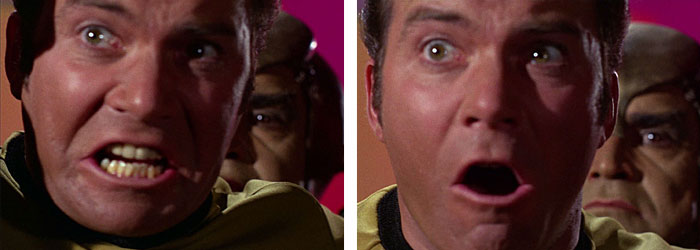 |
|
 |
|
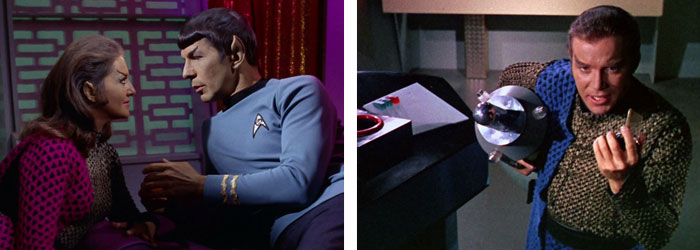 |
|
 |
|
An unusually tense and irritable Kirk
orders his ship into the Romulan Neutral Zone, where it is promptly
surrounded. Beamed to a Romulan ship, Kirk lies about the intrusion,
then attacks Spock, who responds with a Vulcan death grip. While the
female Romulan commander courts Spock, a secret mission unfolds. |
|
Director: John Meredyth Lucas
Writer: D.C. Fontana |
|
Guest starring: Joanne Linville, Jack
Donner, Richard Compton, Robert Gentile, Mike Howden, Gordon Coffey |
|
 |
|
 |
|
In the opening segment, in regard to the
enemy vessels, Spock declares "Romulans now using Klingon
design!" The actual reason for this was that in unpacking the
models to shoot this sequence, a production assistant stepped on and
broke the Romulan Warbird model that was going to be used, so they
pulled out their Klingon Battlecruiser model and wrote the line to
cover it up. |
|
 |
|
First broadcast episode of Star Trek: The
Original Series to feature the D7 Klingon battle cruisers. Although
the episode Star Trek: Elaan of Troyius (1968) was produced 3 months
before this episode, and technically the first to feature the D7s,
this episode was aired on TV first, since NBC changed the airing
order for all the episodes. For the Remastered series in 2006,
digital shots of the D7s were inserted into scenes in the episode
Star Trek: Errand of Mercy (1967), which now officially makes that
episode to be the first to have the D7s. |
|
 |
|
 |
|
Transporter beams cannot penetrate
shields, yet Kirk is able to beam to the Romulan flagship and back.
This means that the Enterprise and the Romulan warships have their
shields down, an unlikely scenario with hostile warships facing one another. |
|
 |
|
|
3.
The Paradise Syndrome |
October 4, 1968 |
|
|
"It's like discovering Atlantis. Or Shangri-La." |
|
- Captain James T. Kirk |
|
 |
|
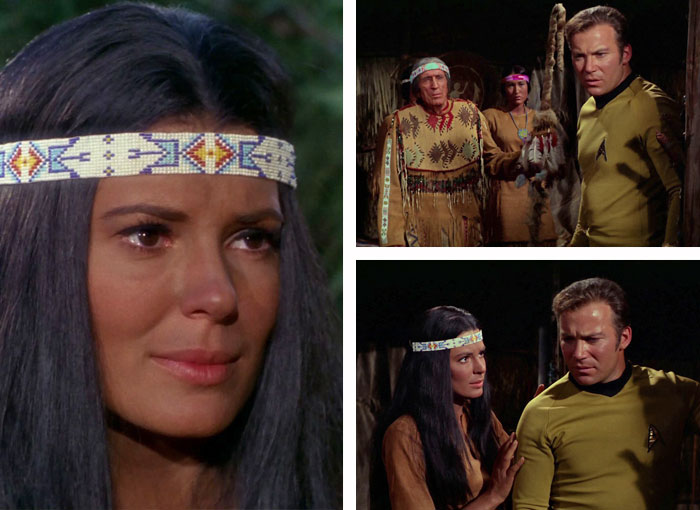 |
|
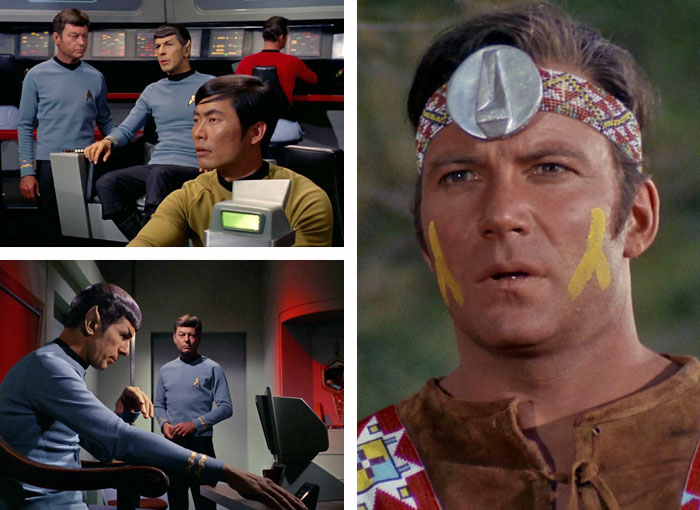 |
|
 |
|
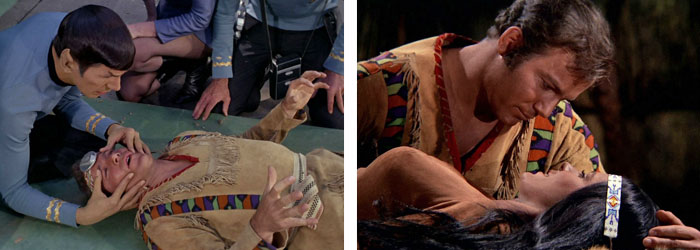 |
|
Kirk, Spock and McCoy beam down to a
planet to inform any inhabitants that they must evacuate the planet
due to an approaching asteroid's imminent collision. A society
similar to Native American Indians has arisen on the planet, but near
their villages, the landing party finds a strange obelisk whose
design and construction is far beyond the capabilities of the
planet's natives. Kirk finds that the monolith can be opened by the
combination of sounds found in the order "Kirk to
Enterprise," but when he enters the obelisk, he is attacked by
waves of energy that erase his mind. With no time to spare, Spock and
McCoy have to return to the Enterprise without Kirk, and begin trying
to use the ship's tractor beam to divert the asteroid. Meanwhile,
Kirk becomes the tribal chief, takes a wife and even expects to
become a father, but the Enterprise may not be able to save her
former captain's future. |
|
Director: Jud Taylor
Writer: Margaret Armen |
|
Guest starring: Richard Geary, Sabrina
Scharf, Rudy Solari, Richard Hale, Naomi Pollack, John Lindesmith,
Peter Virgo Jr., Lamont Laird |
|
 |
|
 |
|
 The
"obelisk" in this episode, constructed at Franklin Lake in
the Franklin Canyon Reservoir above Beverly Hills, was erected in the
same spot where Opie Taylor throws a rock into the lake during the
opening credits of "The Andy Griffith Show". The
"obelisk" in this episode, constructed at Franklin Lake in
the Franklin Canyon Reservoir above Beverly Hills, was erected in the
same spot where Opie Taylor throws a rock into the lake during the
opening credits of "The Andy Griffith Show".
The first Star Trek production to feature
Native American Indian culture as a key plot element. Other examples
are Star Trek: The Animated Series: How Sharper Than a Serpent's
Tooth (1974), Star Trek: The Next Generation: Journey's End (1994),
and several episodes of Star Trek: Voyager (1995). Yet, the Native
Americans depicted display none of the cultural elements of the
tribes mentioned (Navajo, Delaware, Mohican). The houses are tipis,
used by plains peoples. The clothing bears no resemblance to actual
Native American clothes, and the names of the characters match no
Native naming styles. Also, the Navajo were not peaceful, but were
very fierce warriors. The Mohican are a fictitious tribe created for
the stories of James Fenimore Cooper who combined the names Mohawk
and Mohegan, also warrior tribes. The Delaware were not called
"Delaware," but rather, were the Lenne Lenape, as a scholar
should refer to them in formal references. |
|
 |
|
|
|
 |
|
Episode: The Paradise Syndrome |
|
On a planet with a society similar the
Native American Indians, "Kirok" loses his Starfleet
uniform in favor of native attire. He eventually loses that shirt as well. |
|
 |
|
|
 |
|
 |
|
Spock orders the Enterprise to rush
towards the asteroid at Warp Nine. This seems to imply the asteroid
would be far outside the planetary system, possibly light years away.
This would mean the asteroid would require thousands of years to
reach the planet and an imminent collision was not about to happen.
When debating on whether to return to the
ship or search for Kirk, McCoy exclaims that the asteroid won't reach
the planet for two months; however, later in the same conversation,
Spock uses two rocks to show the position of the planet and the
changing position of the asteroid. If the speed of Spock's
"example" is correct, the asteroid will hit the planet in
mere minutes, not months. |
|
 |
|
|
4.
And the Children Shall Lead |
October 11, 1968 |
|
|
"Captain's log, supplementary. We
have buried the members of the Starnes exploration party. Everyone
has been deeply affected by what has happened here - with some
important exceptions." |
|
- Captain James T. Kirk |
|
 |
|
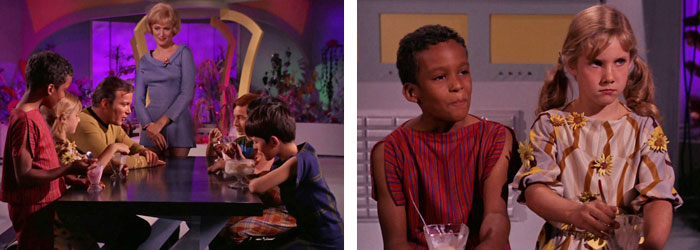 |
|
 |
|
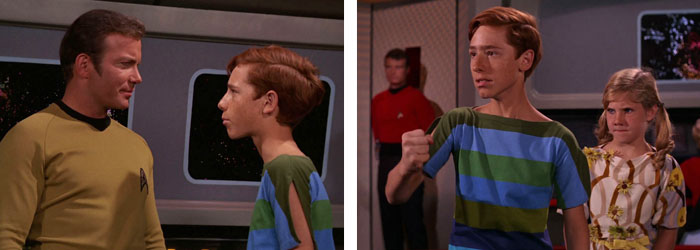 |
|
 |
|
The Enterprise responds to a distress call
from the scientific colony on Triacus and arrives to find that all of
the adults are dead. Oddly, the children seem unaffected by the
deaths and continue to play as if nothing had happened. Logs reveal
that the expedition had discovered an ancient civilization and warn
about an "enemy from within". |
|
Director: Marvin J. Chomsky
Writer: Edward J. Lakso |
|
Guest starring: Dick Dial, Jay D. Jones,
Craig Hundley, James Wellman, Melvin Belli, Pamelyn Ferdin, Caesar
Belli, Mark Robert Brown, Brian Tochi, Lou Elias |
|
 |
|
 |
|
Casting notes: Craig Huxley (Tommy
Starnes) previously appeared in Star Trek: Operation - Annihilate!
(1967) as Kirk's nephew Peter. This was lawyer Melvin Belli's first
time playing a fictional character. His son Melvin Caesar Belli plays
one of the children. Producer Fred Freiberger hoped that the presence
of Melvin Belli would boost ratings. This plan failed and Freiberger
realized it would have been more appropriate to cast an actor in the role.
This is the only episode of the original
series in which we see the fully fledged United Federation of Planets
flag. Previous appearances, such as Star Trek: The Menagerie: Part II
(1966), simply used the pre-existing United Nations flag. |
|
 |
|
This episode is the first appearance of
the set piece depicting the entrance to the Gorgan's cave. It would
be seen again in many third season episodes, including Star Trek:
Spock's Brain (1968), Star Trek: The Cloud Minders (1969), Star Trek:
All Our Yesterdays (1969), and Star Trek: That Which Survives (1969).
This episode borrows elements and concepts
from several sources, including Greek mythology (Gorgon), the old
testament (the Book of Isaiah), and puritanical/colonial witchery
(the incantations). It also has a similar plot to the first-season
episode Star Trek: Charlie X (1966).
All eight major regular performers of the
second and third seasons - Kirk, Spock, McCoy, Scotty, Sulu, Uhura,
Chapel, and Chekov - appear in this episode.
Originally, the children were supposed to
enchant the ENTERPRISE crew by chanting, "See, see, what shall
(s)he see..." and then completing the chant by describing the
effect of the chant on the crew member. However, these chants were
dropped, and in the final episode, the children use their powers by
moving their fists up and down in the air. The only chant that is
heard in the episode is the one that summons the Angel, Gorgan. In
James Blish's novelization of this episode, the children sing spells
to cause havoc among the crew rather than making the fist-pumping
gesture which has earned a lot of ridicule among fans. |
|
 |
|
 |
|
The stardates the Enterprise and Professor
Starn's scientific team used apparently do not match up. The opening
stardate of 5049.5 would have made more sense than the 5029.5 quoted
on the captain's log. |
|
|
 |
|
 |
|
Episode: "And
The Children Shall Lead"
Crewman, 2 Security Officers
- Beamed into open space under the induced
illusion that the ship was still in orbit. |
|
|
|
 |
|
|
5.
Is There in Truth No Beauty? |
October 18, 1968 |
|
|
"Captain's log, stardate 5630.7. We
have been assigned to convey the Medusans' ambassador to the
Federation back to their home planet. While the thoughts of the
Medusans are the most sublime in the galaxy, their physical
appearance is exactly the opposite. They have evolved into a race of
beings who are formless, so utterly hideous that the sight of a
Medusan brings total madness to any human who sees one." |
|
- Captain James T. Kirk |
|
 |
|
 |
|
 |
|
 |
|
 |
|
Miranda Jones, a telepath who studied
mental disciplines on Vulcan, arrives with Ambassador Kolos, a
Medusan - an alien life form whose physical form is so hideous,
humanoid life forms are driven insane if they look upon him. Also
beaming aboard is Larry Marvick, one of the original designers of the
Enterprise - and hopelessly in love with Miranda, although she has
chosen to spend her life serving as a liason between the Medusans and
other humanoids. Miranda senses that someone is actively
contemplating murder, and suspects Spock is envious of her
once-in-a-lifetime mission - but even Miranda is unaware of the real
would-be killer and their target. |
|
Director: Ralph Senensky
Writer: Jean Lisette Aroeste |
|
Guest starring: Diana Muldaur, David
Frankham, Richard Geary, Robert Balver, Vince Deadrick, William
Blackburn, Ralph Garrett, Alan Gibbs |
|
 |
|
 |
|
The dinner scene marks the first
presentation of the Vulcan IDIC (Infinite Diversity in Infinite
Combinations) symbol. Although often cited by some fans as evidence
of a "larger message" in Star Trek, the "IDIC"
("Infinite Diversity in Infinite Combinations") medallion
that Spock wears during the dinner scene had much baser origins.
Leonard Nimoy was originally supposed to give a lengthy speech about
the medallion and what it represented. Nimoy found the speech
completely out of context in the scene and the episode and refused to
say the lines until he got an explanation from producer Gene
Roddenberry, who had had the lines and the use of the medallion
inserted into the episode. Roddenberry came to the set and admitted
to Nimoy that he was selling the "IDIC" medallions through
his personal marketing company, Lincoln Enterprises, and inserted the
scene about the "IDIC" purely as product placement to
generate sales. Nimoy ultimately refused to say the lines, and
instead the scene was re-written with Capt. Kirk and other characters
commenting on Spock's wearing of the medallion instead. |
|
 |
|
In Star Trek: Enterprise (2001) it is
explained that Commander Trip Tucker (Connor Trinneer) designed the
Constitution-class Enterprise warp engines that Doctor Larry Marvick
(David Frankham) commandeers from Scott.
It is commented by McCoy that a blind
person couldn't pilot a space craft. However, on Star Trek The Next
Generation, the blind Geordi LaForge piloted the Enterprise-D as the
ship's helmsman during the show's first season. Dr Jones Neural Net
can almost be seen as a precursor to LaForge's VISOR.
Diana Muldaur was given a dark wig to wear
for the role of Miranda. This was largely to help distinguish the
character from her previous guest role as Dr Ann Mulhall in Return To Tomorrow. |
|
 |
|
 |
|
When Miranda shouts "That's a
lie!", Kirk responds, "Oh, yes it is!", revealing that
Diana Muldaur should have said "That's not true!".
Towards the end of the scene where Kirk
and McCoy discuss Miranda, Kirk finishes his drink swallowing the
very last drop. The next cut then shows the cup is still quarter full
without sufficient time for a re-fill.
Shortly after the merged Spock/Kollos
entity engages Warp 1 to get the enterprise out of the void beyond
the universe, Spock is seen in the helmsman's chair in his blue
shirt. The next shot shows Chekov sitting next to another man in a
yellow shirt. The very next scene again shows Spock in his blue shirt
still in the helmsman's chair, with Sulu still standing back with the others. |
|
 |
|
|
6.
Spectre of the Gun |
October 25, 1968 |
|
|
"Aliens. You have encroached on the
space of the Melkot. You will turn back immediately. This is the only
warning you will receive." |
|
- voice of Melkotian Buoy |
|
 |
|
 |
|
 |
|
 |
|
 |
|
 |
|
When coming to an exaphobic isolationist
planet, Captain Kirk and his landing party are punished for
trepassing. They are sentenced to death in a surreal recreation of
the Gunfight at the OK Corral with the Enterprise crew members on the
losing side. |
|
Director: Vincent McEveety
Writer: Lee Cronin |
|
Guest starring: Richard Anthony, Paul
Baxley, Ron Soble, Bonnie Beecher, Charles Maxwell, Rex Holman, Sam
Gilman, Charles Seel, Bill Zuckert, Ed McCready, Abraham Sofaer,
Gregg Palmer, Bob Orrison, Gregory Reece |
|
 |
|
 |
|
DeForest Kelley appeared in other
dramatizations of the same historical events, playing Ike Clanton in
You Are There: The Gunfight at the O.K. Corral (October 26th, 1881)
(1955) and Morgan Earp in Gunfight at the O.K. Corral (1957). He was
also offered a role in Hour of the Gun (1967) (the movie this episode
is named after) but had to decline due to his Star Trek commitment. |
|
 |
|
Though originally intended to be filmed on
a back lot set of an Old West town, when the series budget was
heavily cut, it was decided to film it in a surrealistic style
(half-completed buildings, shadows on the "sky" backdrop,
etc.) on an interior set.
Written by Lee Cronin, the pseudonym of
Gene L. Coon. Some have assumed that it was used because he was
unhappy with the results. Actually, it was because he had left
Paramount and was under contract with Universal, so he was not
supposed to be working for Paramount as well.
This was the first episode produced for
the third season but it aired as the sixth episode of the season. The
writing of this episode was influenced by NBC executives who wanted
Chekov to be featured more in the third season than he had been in
the second season. According to James Doohan, NBC executives told him
to comb his hair back for the third season. Doohan hated wearing his
hair this way and stopped doing so during Star Trek: The Tholian Web
(1968). Doohan also provided the voice of the Melkotian buoy. The
episode was first broadcast on October 25th, 1968, only one day
before the 87th anniversary of the actual Gunfight at the O.K. Corral. |
|
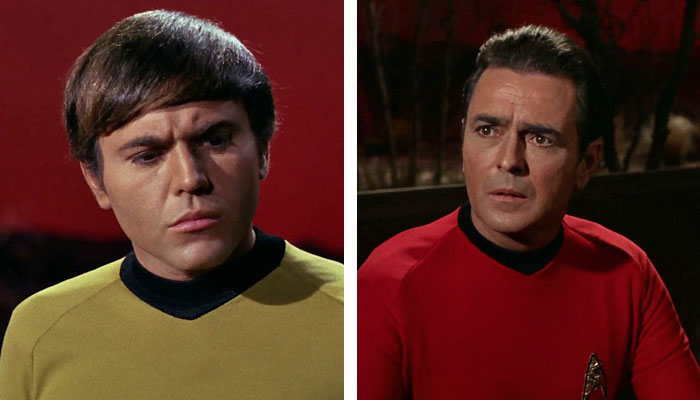 |
|
Although Sam Gilman (Doc Holliday) was 53
years old when this episode was made, Holliday was only 30 at the
time of the Gunfight at the O.K. Corral on October 26th, 1881 and 36
at the time of his death on November 8th, 1887.
For the incomplete mock-up of the
Sheriff's office, the sign with the word "Sheriff" on it is
written in the exact same font as the opening credits to the series
(the F's have the same slant in the center).
Bit-player Rex Holman got his first break
when the actor who was originally cast as Morgan Earp proved
difficult to work with and was fired. Director Vincent McEveety
elevated Holman from being an extra to a supporting part. Two decades
later he returned to the Trek universe playing a supporting part in
Star Trek V: The Final Frontier (1989).
There is a slight variation on Dr. McCoy's
catchphrase: "He's dead, Jim." When Chekov "dies",
McCoy says: "There's nothing I can do, Jim." |
|
 |
|
 |
|
The gunfight at the O K Corral has many
inaccuracies, but that's because the Melkotian created the town based
on Captain Kirk's imperfect subconscious knowledge of history. The
gunfight actually ensued at 3:00 p.m., not 5:00 p.m. Virgil Earp was
the town marshal of Tombstone at the time of the Gunfight at the O K
Corral, not Wyatt Earp. Morgan Earp was Virgil's deputy, and Wyatt
and Doc Holliday were deputized the day of the gunfight. Their
original intent was to disarm the Clantons and McLaureys. Doc
Holliday did not practice dentistry in Tombstone. Perhaps most
importantly, Ike Clanton (Captain Kirk) was not killed in the
gunfight, but lived for six years afterwards and, in fact, killed
Morgan Earp and arranged to have Virgil Earp ambushed and crippled.
After Kirk, Spock and Co figure out they
are in Tombstone, they repeat the date October 26, 1881 several
times. However when McCoy repeats it he says 1981. |
|
 |
|
|
7.
Day of the Dove |
November 1, 1968 |
|
|
"Captain's Log, stardate...
Armageddon. We must find a way to defeat the alien force of hate that
has taken over the Enterprise, stop the war now - or spend eternity
in futile, bloody violence." |
|
- Captain James T. Kirk |
|
 |
|
 |
|
 |
|
 |
|
 |
|
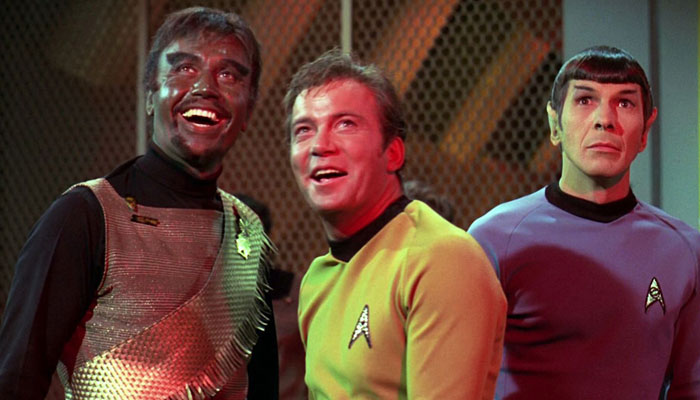 |
|
Both humans and Klingons have been lured
to a planet by a formless entity that feeds on hatred and has set
about to fashion them into a permanent food supply for itself. |
|
Director: Marvin J. Chomsky
Writer: Jerome Bixby |
|
Guest starring: Michael Ansara, Susan
Howard, David L. Ross, Mark Tobin |
|
 |
|
 |
|
At one point, Scotty warns Spock;
"Keep your fulkin' hands off me!" In the script, the line
read as "Vulcan" hands, however just before filming the
scene, writer Jerome Bixby convinced actor James Doohan to replace
Vulcan with fulkin', hoping the Scottish accent would hide the
obscenity. No one noticed, and Bixby managed to sneak America's
favorite curse word onto Network Television, November 1st, 1968.
Mara is the only female Klingon with a
speaking role on Star Trek (1966): The Original Series. Another
female is beamed on board the Enterprise at the same time, but only
seen briefly.
This episode was originally written with
John Colicos' Kor (from Star Trek: Errand of Mercy (1967) as Kirk's
Klingon adversary. Although Colicos really wanted to reprise that
role, he was in Europe making Anne of the Thousand Days (1969), and
was unavailable. The part was recast with Michael Ansara as
"Kang". Ansara is one of nine actors to play the same
character (in his case the Klingon commander Kang) on three Star Trek
television series – the original series ("Day of the
Dove"), Deep Space Nine ("Blood Oath") and Voyager
("Flashback"). Ansara was married to I Dream of Jeannie
star Barbara Eden (1958 to 1974). Ansara and Eden both co-starred in
Irwin Allen's movie Voyage to the Bottom of the Sea. |
|
 |
|
Kang gives his name to one of the two
cyclopic alien squids who repeatedly plague The Simpsons (1989) in
their Halloween fantasies. The other is Kodos who takes his name from
Star Trek: The Conscience of the King (1966).
In the first confrontation with the
Klingons, Kirk tells Kang to "Go to the devil" to which
Kang responds "We have no devil". Later it was decided that
the Klingons do indeed have a "devil": Fek'lhr, the
guardian of the Klingon underworld, first mentioned in Star Trek: The
Next Generation: Devil's Due (1991).
As in the Imperial Starfleet of the Mirror
Universe (first seen in Star Trek: Mirror, Mirror (1967)), the
regular universe's Klingon Empire uses agonizers on Ensign Chekov.
These were developed further as the "painsticks" often seen
on Star Trek: The Next Generation (1987).
Mark Tobin, who plays a Klingon in this
episode, would return more than 30 years later to play a Klingon in
Star Trek: Voyager: Barge of the Dead (1999). He previously played
Khan's right-hand man, Joaquin, in Star Trek: Space Seed (1967). |
|
 |
|
 |
|
 |
|
|
8.
For the World is Hollow
and I Have Touched the Sky |
November 8, 1968 |
|
|
"Captain, informing these people
they're on a ship may be in violation of the Prime Directive of
Starfleet Command." |
|
- Mr. Spock |
|
 |
|
 |
|
 |
|
 |
|
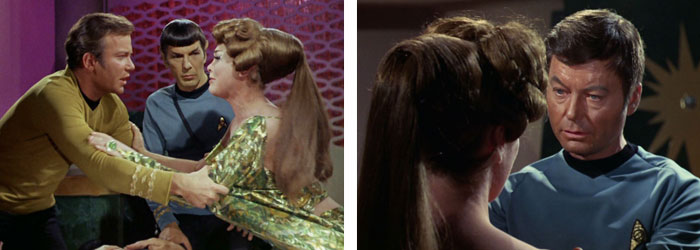 |
|
The Enterprise must deflect an asteroid on
a collision course with an inhabited planet... but discover the
asteroid is a spaceship with a population unaware of the outside world. |
|
Director: Tony Leader
Writer: Hendrik Vollaerts |
|
Guest starring: Katherine Woodville, Byron
Morrow, Jon Lormer |
|
 |
|
 |
|
The voice of the Oracle was played by
James Doohan.
Byron Morrow, who portrayed Admiral
Westervliet, also portrayed Admiral Komack in Star Trek: Amok Time
(1967). Admiral Komack would show up again played by Ben Binswagner
in the 2009 Star Trek reboot. |
|
 |
|
 |
|
When Spock is thumbing through the Book of
the Fabrini, although Kirk asks whether it is indexed, and Spock says
yes, in fact all pages can clearly be seen to be blank until he
reaches the pages he wants. This happens a lot in movies and TV shows
when a character is reading or looking at a book and is kind of a pet
peeve of ours. How hard is it for the prop department to get a real
book with printed pages in it? |
|
 |
|
|
9.
The Tholian Web |
November 15, 1968 |
|
|
"I understand, Doctor. I'm sure the
Captain would simply have said:
Forget it, Bones." |
|
- Mr. Spock |
|
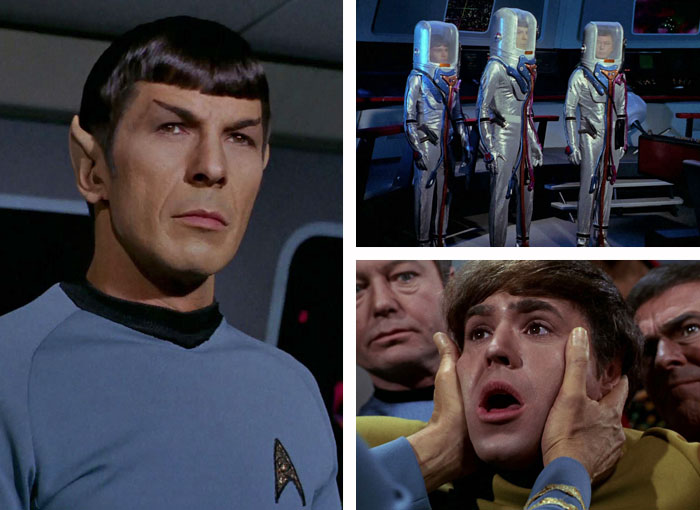 |
|
 |
|
 |
|
 |
|
The Enterprise arrives at the last known
position of the U.S.S. Defiant (NCC-1764), an area of uncharted
space, to search for the missing starship. When the Defiant appears
on the viewing screen enshrouded in a strange green glow, Spock is
unable to scan the vessel on his sensors. Kirk beams over to the
Defiant with a boarding party to investigate and finds the entire
crew dead. What's more, the Defiant seems to be trapped in an
interphase between two different universes. A power loss partially
disables the Enterprise transporter, but the landing party manages to
beam back to the Enterprise except Kirk who suddenly disappears along
with the Defiant. Spock calculates that the next time to interphase
will be approximately two hours, and that the captain can be rescued
at that time. As the Enterprise begins to experience the same
problems that doomed the Defiant: power loss, weakness and insanity
among the crew, an alien vessel appears and demands that they leave Tholian |
|
Director: Ralph Senensky / Herb Wallerstein
Writer: Judy Burns / Chet Richards |
|
Guest starring: Barbara Babcock, Sean
Morgan, Lou Elias, Jay D. Jones |
|
 |
|
 |
|
 According
to a TV Guide interview from 1970, The Tholian Web was the first
script that episode writer Judy Burns (left) ever wrote. She would go
on to write episodes of Mission: Impossible (2 episodes, 1969, 1971),
Search (2 episodes, 1972, 1973), The F.B.I. (1974), Marcus Welby,
M.D. (1974), Ironside (2 episodes, 1974, 1974), Bionic Woman (1976),
The Six Million Dollar Man (4 episodes, 1975, 1976, 1977), Wonder
Woman (1977), Vega$ (4 episodes, 1980, 1981), Fantasy Island (2
episodes, 1980, 1981), Knight Rider (1982), Magnum, P.I. (1984), T.J.
Hooker (5 episodes, 1985) and MacGyver (1985) amoung others. According
to a TV Guide interview from 1970, The Tholian Web was the first
script that episode writer Judy Burns (left) ever wrote. She would go
on to write episodes of Mission: Impossible (2 episodes, 1969, 1971),
Search (2 episodes, 1972, 1973), The F.B.I. (1974), Marcus Welby,
M.D. (1974), Ironside (2 episodes, 1974, 1974), Bionic Woman (1976),
The Six Million Dollar Man (4 episodes, 1975, 1976, 1977), Wonder
Woman (1977), Vega$ (4 episodes, 1980, 1981), Fantasy Island (2
episodes, 1980, 1981), Knight Rider (1982), Magnum, P.I. (1984), T.J.
Hooker (5 episodes, 1985) and MacGyver (1985) amoung others.
When Chekov asks if there's ever before
been a mutiny aboard a starship, Spock responds by saying that there
are absolutely no records of any such occurrence. This cleverly
avoids answering the question directly. While there may be no mutiny
"on record," Spock well knows that there's been at least
one, which he himself took part in, during "The Menagerie"
two-parter from the first season.
Herb Wallerstein is the credited director
of this episode. Ralph Senensky was the original director, but was
fired midway through filming, and replaced by Wallerstein. Senensky
refused any screen credit for this episode.
 First
Star Trek episode to show the environmental suit. Something that was
avoided before not only because of the cost but of the problems of
the suit having to have a helmet with a clear window. Such a window
would always pick up unwanted reflections and make recording the
actor's lines difficult. Since these outfits were only meant to be
seen only in NTSC resolution, someone came up with the ingenious
solution of making the "window" out of mesh. Mesh would
provide the diffusion to make it seem there was something clear and
solid in front of the actor's face and reflections and recording
dialog would be no problem. The way the shows were broadcast back
then it would provide successful illusion of a solid face plate for
the most part. It was not until DVD, which achieved the highest
quality of NTSC resolution that the use of mesh became much more
noticeable. And now, with high definition resolution, you can see the
texture and wrinkling of the mesh quite easily. First
Star Trek episode to show the environmental suit. Something that was
avoided before not only because of the cost but of the problems of
the suit having to have a helmet with a clear window. Such a window
would always pick up unwanted reflections and make recording the
actor's lines difficult. Since these outfits were only meant to be
seen only in NTSC resolution, someone came up with the ingenious
solution of making the "window" out of mesh. Mesh would
provide the diffusion to make it seem there was something clear and
solid in front of the actor's face and reflections and recording
dialog would be no problem. The way the shows were broadcast back
then it would provide successful illusion of a solid face plate for
the most part. It was not until DVD, which achieved the highest
quality of NTSC resolution that the use of mesh became much more
noticeable. And now, with high definition resolution, you can see the
texture and wrinkling of the mesh quite easily.
After the episode is finished the story of
the USS Defiant continues in the prequel series Star Trek: Enterprise
(2001). Mirror universe Captain Archer finds the Defiant being held
by the Tholians in the prime universe to which he commandeers it and
takes it into his native universe in In a Mirror, Darkly: Part 1 and
2 (2005). An effort was made by the production crew to keep
continuity with the bodies in the same spaces and positions. |
|
 |
|
 |
|
Scotty has his hair cut short and combed
down in this episode. But, in one scene, where Spock calls him right
before inter-phase, the scene shows his hair combed back, in the
style he wore in the first few episodes of the third season. That
shot was re-used from Star Trek: The Paradise Syndrome.
While transporting Kirk back onto the
Enterprise there is a close-up of the transporter operator's hands.
His gold bar rank stripe has changed from one to two and he is
missing a finger on the right hand - clearly those are Scotty's hands
and rank. |
|
 |
|
When the landing party first beams aboard
the Defiant, the shot is flopped to maintain continuity of Kirk's
line of sight. Kirk's hair is parted on the right side of his head.
The first shot of Chekov in the Defiant's
engineering room shows him bobbing back and forth unnaturally,
because the film was rolled backward and forward a few times as filler. |
|
 |
|
|
10.
Plato's Stepchildren |
November 22, 1968 |
|
|
"Fascinating. I believe we're
experiencing the psychokinetic manifestations of Parmen's delirium." |
|
- Mr. Spock |
|
 |
|
 |
|
 |
|
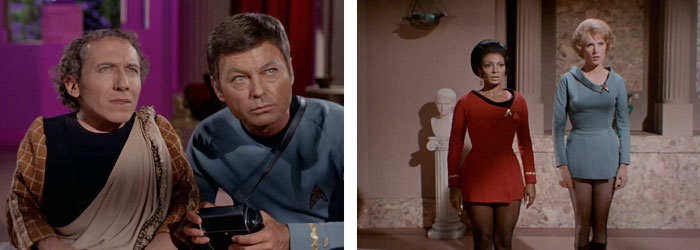 |
|
 |
|
 |
|
Kirk and his crew find themselves at the
mercy of powerful individuals who possess mind-over-matter powers...
and plan to use the Enterprise crew for their twisted entertainment. |
|
Director: David Alexander
Writer: Meyer Dolinsky |
|
Guest starring: Michael Dunn, Liam
Sullivan, Barbara Babcock, Ted Scott, Derek Partridge, Armando
Gonzales, Jay D. Jones |
|
 |
|
 |
|
The first scripted
interracial kiss (between an African-American and a Caucasian) on
American network television was in this episode when Captain Kirk
(William Shatner) kissed Lieutenant Uhura (Nichelle Nichols) when
they were forced to do it by the aliens controlling their bodies. The
studio expressed some concern, and it was suggested instead that
Spock should kiss Uhura 'to make it less of a problem for the
southern [US] audience'. |
|
 |
|
 |
|
Some stations in the South
originally refused to air the episode. Network executives also
ordered the director to shoot a take where he and Uhura did not kiss,
just so it would be available. However William Shatner crossed his
eyes at the camera making the take useless. While this was the first
scripted interracial kiss on American network television (between an
African-American and a Caucasian) it was not the first. |
|
 |
|
On December 11th, 1967,
several months before this Star Trek episode aired Nancy Sinatra
starred in a TV special called "Movin' with Nancy." The
special was directed by Jack Haley, Jr. and showcased Nancy traveling
around singing different songs. Both her dad, Frank Sinatra and
god-uncle Dean Martin make a guest appearances but it is in the
second half of "Movin' with Nancy" where television history
was made when Sammy Davis, Jr. joins Nancy, playing a photographer
who snaps various photos of her as she sings (above). Sammy dances
around, mugs for the camera, and clicks away. Then, at the end of the
bit, Sammy gives Nancy a quick little kiss on the cheek. There is
nothing sexual about the kiss; it is obviously a kiss of great
affection, the affection of two close friends (which they were).
According to Nancy, the apparently spontaneous kiss was actually
carefully planned. She had Sammy shoot the scene late in the day,
knowing he had to leave to get to another job, thus making it
impossible for the brass to ask for a re-take sans the kiss. Sammy
Davis Jr. would make TV history again later when he kissed Archie
Bunker (below left). Predating the Nancy Sinatra special, Dean Martin
and Frank Sinatra would give Diahann Carroll a peck on each cheek
after performing a song on The Dean Martin Show in 1965 (below right). |
|
 |
|
 |
|
And, just a few months
before "Plato’s Stepchildren", the Smothers Brothers
performed a skit that parodied both Bonanza, the show they were up
against in their timeslot, as well as their own well-documented
struggles with CBS censors. The skit features guest stars Rosie
Grier, "Mama" Cass Elliot, and Harry Belafonte as the
“Cartwrong” clan, and towards the end, Grier plants a kiss
right on Elliot’s forehead (above). Just to confuse things,
Grier was playing the "mother" while Cass is playing her
"son". No consideration as an interracial kiss has ever
been given to Captain Kirk kissing Marlena Moreau in "Mirror,
Mirror", a Star Trek episode that aired the year before
"Plato’s Stepchildren". Moreau was played by
mixed-race actress Barbara Luna (below left), who is Italian,
Hungarian, Spanish, Portuguese, and Filipino. |
|
 |
|
While Star Trek can claim
the first scripted interracial kiss between an African-American and a
Caucasian, both The Wild Wild West and I Spy had broadcast
interracial kisses between Caucasian and Asian actors prior to the
Star Trek episode. In the I Spy episode "The Tiger", Robert
Culp travels to Vietnam and meets up with a former flame played by
France Nuyen (above right). The two actors soon became a couple in
real life, with Culp leaving his wife to marry Nuyen. |
|
 |
|
 |
|
There’s a lengthy
tradition of white men romancing Asian women in TV and movies, and
it’s rarely been seen as taboo or offensive. Other white
man/Asian woman interracial kisses include: Darren McGavin and Sondi
Sodsai, Mickey Spillane’s Mike Hammer, 1959, Nobu McCarthy and
Lloyd Bridges, Sea Hunt, 1959 (above top left), Robert Fuller and
Nobu McCarthy, Laramie, 1961 (above top right), Pilar Seurat and
Robert Conrad, The Wild Wild West, 1966 (above botton left), David
McCallum and Victoria Young, The Man from U.N.C.L.E., 1966 (above
bottom right) and France Nuyen and William Shatner, Star Trek, 1968
(below left), an interracial kiss made just a few episodes after
"Plato's Stepchildren". Nuyen has about forty
guest-starring roles on her resume in the 1960s, and it’s
probably safe to assume at least half of them feature her kissing
each show’s respective white lead. In addtion, Shatner kissed an
Asian actress six years prior on the ABC series Naked City (below
right). Would this qualify as an interracial kiss since Shatner was
playing a Burmese sailor named Maung Tun? I don't know (wait-what?
Shathner was Burmese?). The actress Pilar Seurat, would later guest
star on the Star Trek episode "Wolf in the Fold". |
|
 |
|
 |
|
The "actual"
first interracial kiss on television was understood to have occurred
during an episode of the British soap opera Emergency – Ward 10
in 1964 (above center). However, in November 2015, a Granada Play of
the Week, You in Your Small Corner, was uncovered which was broadcast
live in June 1962 (above left). The central theme of the play is a
relationship between a young black intellectual and a white working
class girl. During the play, a kiss takes place between actors Lloyd
Reckord and Elizabeth MacLennan, and what has been described as an
"explicit post-coital scene". So we have a winner? Wait a
minute. Broadcast in the Netherlands in April of 1959, Pension
Hommeles was a television series about the adventures of the
residents of a boarding house. Harlem born American actor Donald
Jones had moved to the Netherlands and became a popular Dutch star,
and shared a kiss with his white co-star on the show (actually more
of an affectionate peck than a full-on kiss, above right).
All this fuss over an
interracial kiss may seem odd today but it was a big deal back then.
To make things even odder some have suggested that Lucy and Ricky
Ricardo qualify as an "interracial couple" and since
real-life husband and wife Desi Arnaz and Lucille Ball kissed many
times on I Love Lucy in the 1950s they should be called the first
interracial kiss on TV. Though Arnaz was hispanic there can be both
white hispanics and black hispanics and Arnaz was usually considered
to be a white male of Cuban ancestry.
In the UK, where
interracial romance had already been depicted on television, the BBC
dropped this episode and subsequent repeats purely on the violence
factor: on the grounds that the sadistic treatment of the Enterprise
Crew was not suitable for its early evening time slot. It was first
shown in the UK on satellite television some 25 years later and on
the BBC in December 1993.
This episode also features
the first and only time both Uhura and Chapel being beamed down to a
planet and are a central part of the storyline, thereafter. |
|
 |
|
|
|
 |
|
Episode: Plato's Stepchildren |
|
The inhabitants of Platonius force Kirk
and Spock to wear clothing inspired by ancient Greece. Kirk's chest
is half exposed, while Spock's is covered. |
|
 |
|
|
 |
|
 |
|
During the performance by Uhura, Nurse
Chapel, Kirk and Spock one of the platonians refers to
"Cupid" a roman deity, that is incorrect because in Greek
mythology the name of the deity is "Eros".
In his Captain's Log, Kirk states that the
Platonians' "planet went nova," planets don't go nova, only stars.
The platonians mention repeatedly Utopia,
it is impossible for them to know the term coined by Thomas More in
1518 as they left Greece centuries before he was born. |
|
 |
|
|
11.
Wink of an Eye |
November 29, 1968 |
|
|
"Ship's Log, Stardate 5710.5,
Lieutenant Commander Scott reporting. While exploring an outer
quadrant of the galaxy, the Enterprise received distress calls from
an apparently uninhabited, incredibly beautiful city on the planet of
Scalos. Captain Kirk and a landing party have beamed down to investigate." |
|
- Montgomery
"Scotty" Scott |
|
 |
|
 |
|
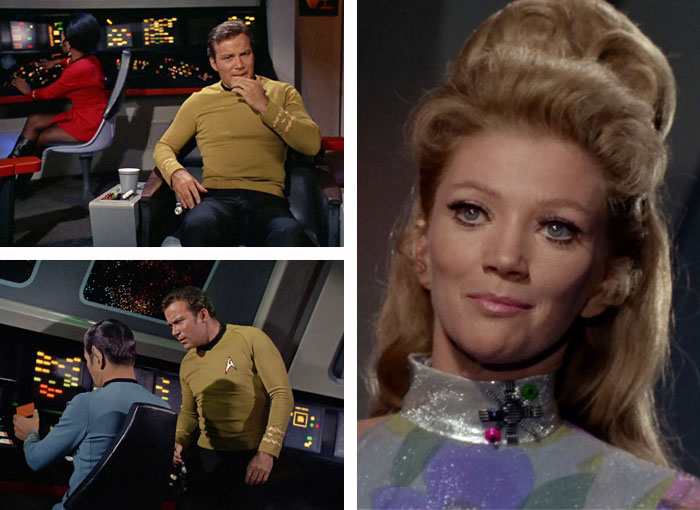 |
|
 |
|
 |
|
 |
|
When a landing party investigating Scalos
begins to vanish one by one, Kirk, Spock and McCoy try to find out
what is happening before more of the crew disappears, until Kirk
himself is abducted. Kirk finds the cause to be a group of endangered
Scalosians who move faster than human sight or hearing can detect.
Kirk must find a way to get a message to Spock and McCoy, who are
working on a cure for the mystery "ailment". |
|
Director: Jud Taylor / Gene L. Coon
Writer: Arthur Heinemann, Lee Cronin |
|
Guest starring: Kathie Browne, Jason
Evers, Erik Holland, Geoffrey Binney, Richard Geary, Ed Hice |
|
 |
|
 |
|
The plot for this episode
(hyper-accelerated movement) was also used in The Wild Wild West: The
Night of the Burning Diamond (1966). That episode was produced by
Gene L. Coon, who wrote this episode under the screen name Lee Cronin.
Concidering Captain Kirk reputation, this
episode contains the only time in The Original Series where Kirk is
seen in what can be presumed to be a post-coital situation. He is
seen zipping up his boots while sitting on the edge of his bed, with
Deela standing nearby arranging her hair.
If it takes the lift doors 1 second to
open and close in real time, accelerated, that would take about 16
minutes. A 30-second ride in the turbo-lift would take 8.3 hours. |
|
 |
|
 |
|
Because archive footage (including footage
from Star Trek: The Empath, which was filmed before this episode) is
used for most of the first minute of the episode, several continuity
errors are caused. Scotty, when making the opening log entry, has the
brushed-back hairstyle James Doohan was forced to use for the first
few episodes of the third season; in the rest of the episode, he has
his normal hairstyle. A woman other than Uhura is at the
communications station in the opening scene, but Uhura is there when
Kirk returns to the bridge. Also Mr. Hadley seems to be playing
musical chairs. Hadley is at the navigation station when Scotty makes
the opening log entry (below left), but when the shot changes to
archive footage of the viewscreen, he is at the helm (below right)
and Chekov is at the navigation station. |
|
 |
|
|
 |
|
 |
|
Episode: "Wink
of an Eye"
Crewman Compton, rank unknown
- Died of rapid cellular decay after a
small injury he suffered in hyperaccelerated state. |
|
|
|
 |
|
|
12.
The Empath |
December 6, 1968 |
|
|
"Why, she seems harmless enough." |
|
- Dr. Leonard
"Bones" McCoy |
|
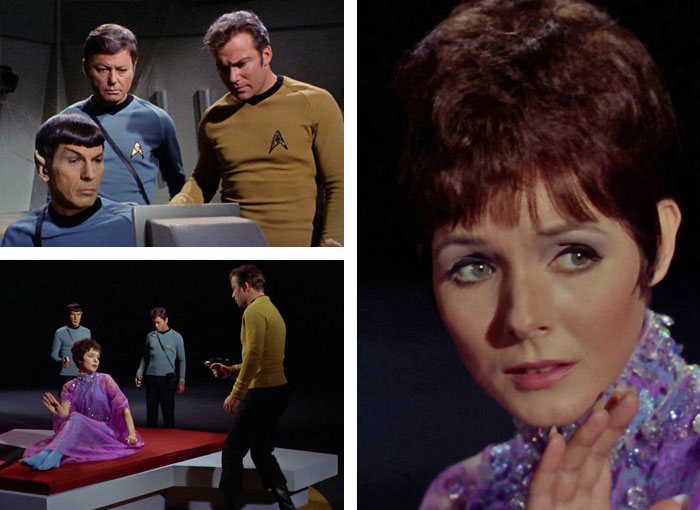 |
|
 |
|
 |
|
 |
|
On a planet doomed to destruction, Kirk,
Spock & McCoy become involved with two aliens who use them as
laboratory animals in a bizarre series of tests on an alien empath
who may be the savior of her planet. |
|
Director: John Erman
Writer: Joyce Muskat |
|
Guest starring: Kathryn Hays, Alan
Bergmann, Davis Roberts, Jason Wingreen, Willard Sage, Roger
Holloway, Jay D. Jones, Paul Baxley |
|
 |
|
 |
|
This was DeForest Kelley's favourite
episode and contains another one of McCoy's famous, "I'm a
doctor, not a..." quotes. In this episode it is "coal miner". |
|
 |
|
|
|
 |
|
Episode: The
Empath |
|
In one scene we can see a shirtless
Shatner dangling from the ceiling as he is being tortured in what
could be the most graphic and violent episode of the original series. |
|
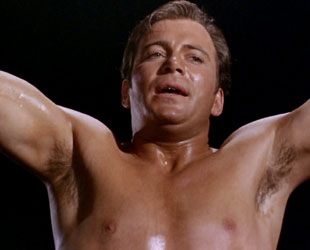 |
|
|
 |
|
|
13.
Elaan of Troyius |
December 20, 1968 |
|
|
"Captain, that ancient Earth custom
called spanking. What is it?" |
|
- Elaan |
|
"It's, er. It's, er. We'll talk about
it later." |
|
- Captain James T. Kirk |
|
 |
|
 |
|
 |
|
While transporting an arrogant, demanding
princess (Elaan) for a political marriage, Captain Kirk must cope
both with her biochemical ability to force him to love her and
sabotage on his ship. |
|
Director: John Meredyth Lucas
Writer: John Meredyth Lucas |
|
Guest starring: France Nuyen, Jay
Robinson, Tony Young, Lee Duncan, Dick Durock, Charles Beck, K.L.
Smith, Victor Brandt |
|
 |
|
 |
|
 |
|
France Nuyen, who plays Elaan, starred
opposite William Shatner on Broadway in "The World of Suzie
Wong" in 1958 (above right). Nuyen is believed to be the first
person of Vietnamese descent to appear on American television.
This plot was revamped more than 20 years
later in the "Captain Picard" adventure Star Trek: The Next
Generation: The Perfect Mate (1992 below). |
|
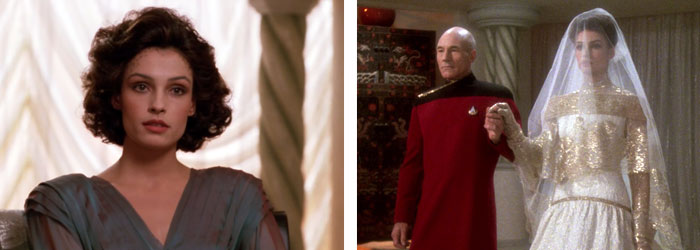 |
|
The story includes elements of both
Homer's "Iliad" (Helen of Troy, represented as Elaan of
Troyius) and William Shakespeare's "Taming of the Shrew".
When Mr. Spock scans the Dohlman's
necklace, the sound the necklace makes is the same as the sound made
by the Martian tripods in The War of the Worlds (1953).
This episode features the first appearance
of the classic D7 Class Klingon battle cruiser, designed and built by
Star Trek art director Walter M. Jefferies (prior to this episode,
Klingon ships had been represented by blobs of light or blips on a
computer screen). Star Trek: Day of the Dove (1968), which was filmed
later, but aired earlier reused shots of the Klingon battle cruiser
from this episode. Walter M. "Matt" Jefferies was born in
1921, in Lebanon, Pennsylvania. From an early age, he became obsessed
with flight. During World War II, he was a B-17 co-pilot in Europe
and Africa; for his service, he received the Bronze Star and the Air
Medal. After World War II, he became an illustrator at the Library of
Congress. After some freelance illustration work in the 1950s, he was
hired as a set designer at Warner Bros. But the 1960s is when he made
his mark. In 1964, Gene Roddenberry approached Matt to design the
ship for a new TV series: Star Trek (1966). The final design of the
original Starship Enterprise became the template for nearly all of
the Federation ships featured in Star Trek ever since. In his honor,
the crawl spaces on Star Trek are called "Jefferies Tubes."
He passed away on July 21st, 2003, of congestive heart failure, after
a fight with cancer. |
|
 |
|
When the camera slowly pans up Elaan's
skimpily clad body (bikini bottom and top) in the transporter, her
belly button is covered due to the 1951 Code of Practices for
Television Broadcasters, which prohibited female navel exposure.
However, a year earlier (Season 2, "Mirror, Mirror"),
Lieutenant Uhura's navel slipped by censors. |
|
 |
|
 |
|
Elaan locks herself away from Kirk and
says: "If I have to stay here for ten light-years I will not be
soiled by any contact with you." The term "light-year"
is a measure of "distance" (the distance traveled by light
in one year), and not of time. |
|
|
 |
|
 |
|
Episode: "Elaan of Troyius"
Crewman Watson Engineer
- Killed by Kryton after discovering
sabotage of the warp core |
|
|
|
 |
|
 |
|
Untitled

|
|
 |
|
|
14.
Whom Gods Destroy |
January 3, 1969 |
|
|
"She seems to have worked out an
infallible method for assuring permanent male fidelity. Interesting." |
|
- Mr. Spock: [about Marta] |
|
 |
|
 |
|
 |
|
 |
|
 |
|
Kirk and Spock investigate an insane
asylum where a former Starfleet captain is being held, only to
discover that he has freed the inmates and is running the place. |
|
Director: Herb Wallerstein / Lee Erwin
Writer: Lee Erwin |
|
Guest starring: Steve Ihnat, Yvonne Craig,
Richard Geary, Gary Downey, Keye Luke, Frank da Vinci, Roger Holloway |
|
 |
|
 |
|
Although Garth is a former Starfleet
captain whose exploits were studied by Kirk at Starfleet Acadamy (and
thus is at least a decade older than Kirk), the actor who played
Garth - Steve Ihnat - is 3 years younger than William Shatner (Kirk).
This episode and the movie "Star
Trek: The Undiscovered Country" both have characters by the name
of Marta and a shape shifter who becomes Captain Kirk. |
|
 |
|
 |
|
When Marta is attempting to stab Kirk, the
camera shows a close-up of Captain Kirk holding back Marta's arm. If
you look closely, you can see the green body make-up on Yvonne Craig
starting to rub off on William Shatner's hands and left sleeve of his
tunic. In some scenes, you can also see that the make-up wasn't
applied to the bottom of her feet. |
|
 |
|
 |
|
 |
|
|
15.
Let That Be Your Last Battlefield |
January 10, 1969 |
|
|
"Lokai is white on the right side.
All of his people are white on the right side." |
|
- Bele |
|
 |
|
 |
|
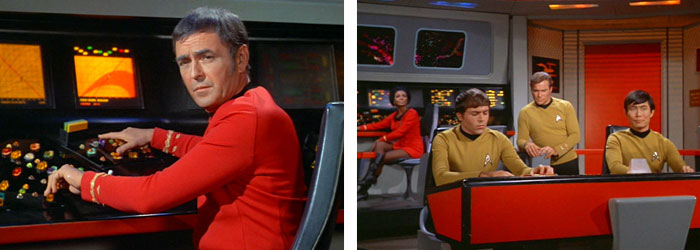 |
|
The Enterprise finds itself host to two
alien beings from the same planet, who share an intense and
self-destructive hatred of each other. |
|
Director: Jud Taylor / Gene L. Coon
Writer: Oliver Crawford |
|
Guest starring: Frank Gorshin, Lou
Antonio, Dick Ziker |
|
 |
|
 |
|
The episode's plot was a clear and not too
subtle indictment of the discrimination and prejudice which was still
rampant in the late 1960s by showcasing its complete absurdity,
especially in light of the assassination of Martin Luther King less
than a year prior, and just a few years after the Watts Riots and the
events later depicted in the films Ghosts of Mississippi (1996),
Malcolm X (1992) and Mississippi Burning (1988). The white/black and
black/white makeup was also a rather obvious allegory to the tension
that existed between many whites and blacks, especially in the
Southern United States. At the beginning of the episode Captain Kirk
refers to the planet Charon "in the southern-most part of the galaxy."
Every time there is a "red
alert", the camera quickly and repeatedly zooms in and out of a
shot of the one of the many flashing, red warning lights which
indicate the red alert. This camera effect was only used in this
episode and is thought to be as a homage to Frank Gorshin's Riddler
character of the Batman TV series. |
|
 |
|
The characters of Bele (Frank Gorshin) and
Lokai (Lou Antonio) both wear shirts which are not pullovers but
instead zip up the back. This was because makeup application with the
shirts on would have soiled the shirts, and pulling shirts over their
heads after the makeup was applied would have disturbed the makeup.
The characters are also depicted as wearing gloves all the time. This
was not because it was a requirement of the script or character
descriptions, but because the black and white makeup would have
smudged and rubbed off every time their hands touched anything or any
other character.
Archive stock footage of World War II-era
London, England burning was shown, superimposed on the fleeing scenes
of Lokai and Bele. In the digitally enhanced version, the archive
stock footage has been cut out. |
|
 |
|
 |
|
Chekov reports that Bele's ship is
"out there" while at his station at the helm. When the
camera shot from behind the helm shows Kirk and crew looking at the
display screen appears, Chekov is not at the helm, but rather Hadley.
When they cut back to a shot from the front angle as before to show
the crew's faces, Chekov is back in his seat.
Although the shuttle-craft is stolen from
Starbase 4, it's side clearly reads: "U.S.S. Enterprise
NCC-1701/7" (archive footage from Star Trek: The Galileo Seven).
In the digitally enhanced version, the number has been changed to SB4-0314/2. |
|
 |
|
|
16.
The Mark of Gideon |
January 17, 1969 |
|
|
"Captain's Log, stardate 5423.4: We
are orbiting the planet Gideon, which is still not a member of the
United Federation of Planets. The treaty negotiations have been
difficult because Gideon has consistently refused the presence of a
delegation from the Federation on its soil or any surveillance by the
ship's sensors. They have finally agreed to a delegation of one. They
insisted it be the captain of the Enterprise. I am, therefore,
beaming down at once." |
|
- Captain James T. Kirk |
|
 |
|
 |
|
Kirk beams down on a diplomatic mission...
and finds himself in an Enterprise where all the crew have vanished
and only a mysterious woman resides. |
|
Director: Jud Taylor
Writer: Stanley Adams / George F. Slavin |
|
Guest starring: Richard Derr, Gene
Dynarski, David Hurst, Sharon Acker |
|
 |
|
 |
|
The voice of the captain of the Astral
Queen is that of Gene Roddenberry.
The episode was written by Stanley Adams,
who had earlier guest starred as Cyrano Jones in The Trouble With
Tribbles. Adams has become concerned over the issue of
overpopulation, and during production of The Trouble With Tribbles,
mentioned to Gene Roddenberry that he thought it would be an
interesting social topic for the series to address. Adams however
said he was disappointed by the episode's final results.
The coordinates given for Kirk to
transport down to the council chamber are 875 020 079. The
coordinates the council member give Scotty to have him be him up from
our 875 020 709.
McCoy makes a sarcastic remark regarding
Spock having a career as a Diplomat. Spock would go on to have a
career in diplomacy, working as an ambassador during the time of Star
Trek The Next Generation. |
|
 |
|
 |
|
Gideon is an overcrowded planet where
every surface is covered by people rubbing up against one another,
which raises some, dare I say it, fasinating questions. With
literally no moving space, how do they keep their infrastructure,
basic utilities and government functioning? How does their society
derive sustenance, and contend with body wastes? The Gidion's want to
introduce disease to help thin the population but people forced to
live on top of each other like that should be a breeding ground for
any number of fatal ailments. Gideon supposedly has "no
room," yet their government council chamber has plenty of empty
space and is downright spacious? Where did they find the space to
build a life-sized replica of the Enterprise let alone get the
information necessary to make a foolproof mock up of the Enterprise
interior? You figure if they had technology to build a "fake
Enterprise" they could figure out their over population problem? |
|
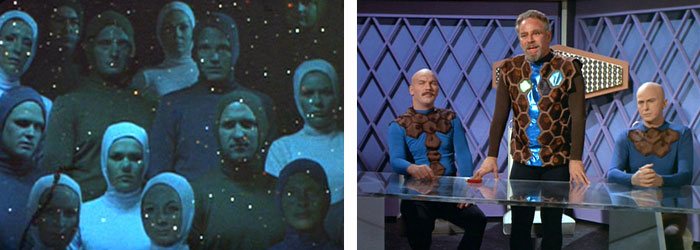 |
|
 |
|
|
17.
That Which Survives |
January 24, 1969 |
|
|
"What happened?" |
|
- Uhura |
|
"The occipital area of my head seems
to have impacted with the arm of the chair." |
|
- Mr. Spock |
|
"No, Mr. Spock. I meant what happened
to us?" |
|
- Uhura |
|
 |
|
 |
|
 |
|
Kirk, McCoy, and Sulu are stranded on a
barren planet where a mysterious woman attempts to kill them one at a
time, while the Enterprise must travel halfway across the galaxy to
rescue them. |
|
Director: Herb Wallerstein / D.C. Fontana
Writer: John Meredyth Lucas |
|
Guest starring: Kenneth Washington, Brad
Forrest, Booker Bradshaw, Naomi Pollack, Arthur Batanides, Lee Meriwether |
|
 |
|
 |
|
 Lt.
Radha (played by Naomi Pollack, left) is both the first explicitly
Hindu character (shown by the bright red dot on her forehead, known
as a Bindi), and the first Enterprise helmswoman, to appear in Star Trek. Lt.
Radha (played by Naomi Pollack, left) is both the first explicitly
Hindu character (shown by the bright red dot on her forehead, known
as a Bindi), and the first Enterprise helmswoman, to appear in Star Trek.
James Doohan lost a finger while fighting
in WWII, and consistently hid his right hand during the series. While
changing polarity on the magnetic probe, the missing finger can be seen.
After D'Amato dies, Kirk uses his phaser
to dig a grave for him. This is only the second time on Star Trek
where a crewman is buried by the landing party on a planet, the first
occurring in Star Trek: The Galileo Seven (1967). Usually, dead
crewmen are returned to the ship.
Second and final appearance of Dr. M'Benga
(played by Booker Bradshaw, 1940–2003) M'Benga was a doctor who
served aboard the U.S.S. Enterprise NCC-1701 for two years. His
background included an internship in a Vulcan ward and he helped save
Spock's life in 2267. |
|
 |
|
 |
|
The Enterprise was thrown 990.7
light-years from the planet they were investigating, then return in
about 1 day. However 7 whole seasons of Star Trek: Voyager were based
on the idea that it will take 70 years to travel 70,000 light-years.
With the rate stated in this episode, Voyager should've passed that
distance in little over a month. |
|
|
 |
|
 |
|
Episode: "That
Which Survives"
Ensign Wyatt, Transporter Chief
Crewman John B. Watkins, Engineer Grade 4
- Killed by Losira's touch. |
|
|
|
 |
|
|
18.
The Lights of Zetar |
January 31, 1969 |
|
|
"When a man of Scotty's years falls
in love, the loneliness of his life is suddenly revealed to him. His
whole heart once throbbed only to the ship's engines." |
|
- Captain James T. Kirk |
|
 |
|
 |
|
 |
|
The Enterprise is on course to install new
equipment on Memory Alpha, the central library storage facility for
the Federation. Chief Engineer Scott has been working closely on the
project with Lieutenant Mira Romaine with whom he has been forming a
romantic attachment. When the Enterprise arrives they must deal with
discorporeal cloud-like corporeal aliens who have already destroyed
the inhabitants of a library planet and plan to eliminate the
Enterprise crew if they cannot acquire a human host. |
|
Director: Herb Kenwith
Writer: Shari Lewis / Jeremy Tarcher |
|
Guest starring: Barbara Babcock, Bud da
Vinci, Libby Erwin, Jan Shutan |
|
 |
|
 |
|
This episode was co-written by Shari Lewis
(of Lamb Chop fame) and her husband Jeremy Tarcher. Lewis also
lobbied to be cast in the guest role of Lt Romaine, but didn't get
the part.
Star Trek: The Original Series is known as
a great science fiction series but some of its stories contain
archetypes of horror. This is the seventh of eight stories that
contain a "ghost" (whether supernatural or metaphorical).
Other (space) ghosts episodes include: What Are Little Girls Made Of?
(1966), Star Trek: Space Seed (1967), Star Trek: Who Mourns for
Adonais? (1967), Star Trek: The Doomsday Machine (1967), Star Trek:
Return to Tomorrow (1968), Star Trek: And the Children Shall Lead
(1968), and Star Trek: The Savage Curtain (1969). |
|
 |
|
 |
|
At 48:00 (for 10 seconds) Kirk, McCoy and
Spock are speaking - through the doorway behind McCoy, you can see a
discarded newspaper lying on the floor that one of the (TV) crew
members apparently left on the set. It is still there at 48:58 for
another 25 seconds or so.
After the first lights attack, a close up
shot of Sulu is reversed: notice his hair is parted the wrong way. On
Memory Alpha, the positions of the dead Andorian and alien in the
purple jumpsuit change between angles and a dead technician dies is
still visibly breathing. Lt. Romaine has a cold sore on her lower lip
that comes and goes between scenes. |
|
 |
|
|
19.
Requiem for Methuselah |
February 14, 1969 |
|
|
"Captain's log, stardate 5843.7. The
Enterprise is in the grip of a raging epidemic. Three crewmen have
died and twenty-three others have been struck down by Rigelian fever.
In order to combat the illness, Dr. McCoy needs large quantities of
ryetalyn, which is the only known antidote for the fever. Our sensors
have picked up sufficient quantities of pure ryetalyn on a small
planet in the Omega system. We are beaming down to secure this
urgently needed material." |
|
- Captain James T. Kirk |
|
 |
|
 |
|
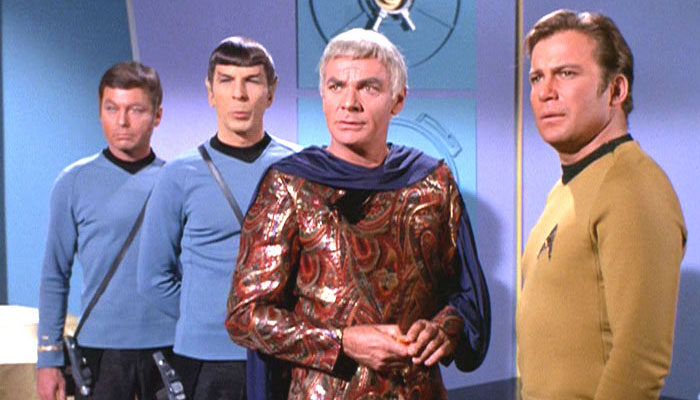 |
|
 |
|
While seeking a cure for a fever ravaging
the Enterprise, Kirk and Spock encounter Flint, a hermit-like
Earthman, and his beautiful young ward. |
|
Director: Murray Golden
Writer: Jerome Bixby |
|
Guest starring: John Buonomo, James Daly,
Louise Sorel, Phil Adams |
|
 |
|
 |
|
One of many Star Trek productions
resembling William Shakespeare's The Tempest and/or Irving Block's
Forbidden Planet (1956). This tragic love story was first aired on
Valentine's Day, February 14th, 1969.
The last name of Rayna Kapec is an anagram
of the last name of Karel Capek, the Czech author who popularized the
term "robot".
Mr. Flint invites Kirk, Spock and Bones to
his palace, which is the same as seen from afar in Star Trek: The
Cage (1986): an Eastern palace with blue details, golden rooftops, a
giant moon or other planet in the background left and a smaller, Saturn-like
planet left of that. In The Cage this is the stage for the fight
between Captain Pike and the monster. In the remastered Star Trek,
this image was replaced with a new background. |
|
 |
|
 |
|
The sheet music for Flint's Johannes
Brahms waltz, which we see in a close-up, does not correspond to the
waltz Spock has played. |
|
 |
|
|
20.
The Way to Eden |
February 21, 1969 |
|
|
"I used to get into a little trouble
when I was that age, Scotty, didn't you?" |
|
- Captain James T. Kirk |
|
 |
|
 |
|
 |
|
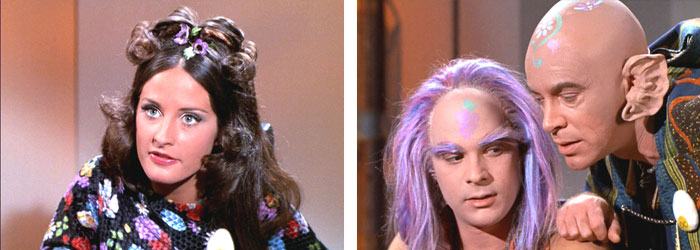 |
|
 |
|
The Enterprise picks up a group of space
"hippies" looking for Eden. |
|
Director: David Alexander / D.C. Fontana
Writer: Arthur Heinemann |
|
Guest starring: Phyllis Douglas, Deborah
Downey, Victor Brandt, Mary Linda Rapelye, Elizabeth Rogers, Charles
Napier, Skip Homeier |
|
 |
|
 |
|
In this episode, for the first time,
Chekov's first and middle names are spoken/revealed, Pavel Andreivich.
The space hippie protest "Herbert,
Herbert, Herbert!" is a gag, referring to both Star Trek four
time director Herb Wallerstein, and long time Executive in Charge of
Production Herbert F. Solow. Spock tells Kirk that the reference to
Herbert is "somewhat uncomplimentary" and that "Herbert
was a minor official, notorious for his rigid and limited patterns
of thought."
Dr. Sevrin is based on Timothy Leary, a
controversial psychiatrist who advocated LSD as a therapeutic drug.
This episode was originally entitled
"Joanna." The character of Irina was originally to be
Joanna McCoy, daughter of Dr. McCoy, and love interest for Captain
Kirk, but that original script was rejected. The character of Joanna
was planned to later appear in the fourth season, but Star Trek
(1966) was canceled at the end of the third season.
MoJo connection: Star Trek guest stars,
Charles Napier (The Way to Eden) and Clint Howard (Star Trek: The
Corbomite Maneuver (1966)) played a scene together in Austin Powers:
International Man of Mystery (1997). |
|
 |
|
 |
|
Two times, a shot of Kirk is reversed
(presumably to make him face the right side of the screen) The first
time he is facing Sulu in a corridor of the Enterprise, the second he
is looking where Dr. Sevrin had just run on the planet Eden. Note the
appearance of the Star Fleet emblem on the right side of his shirt,
rather than the usual left side. |
|
 |
|
|
21.
The Cloud Minders |
February 28, 1969 |
|
|
"This troubled planet is a place of
the most violent contrasts.
Those who receive the rewards are totally
separated from those who shoulder the burdens. It is not a wise leadership." |
|
- Mr. Spock |
|
 |
|
 |
|
 |
|
 |
|
Kirk and Spock are caught up in a
revolution on a planet where intellectuals and artists live on a
utopian city in the sky while the rest of the population toils in
mines on the barren surface below. |
|
Director: Jud Taylor / David Gerrold
Writer: Margaret Armen |
|
Guest starring: Ed Long, Garth Pillsbury,
Fred Williamson, Kirk Raymone, Charlene Polite, Diana Ewing, Jeff
Corey, Harv Selsby, Jimmy Fields, Jay D. Jones, Richard Geary, Marvin
Walters, Lou Elias, Walter Scott, Bob Myles |
|
 |
|
 |
|
 Fred
Williamson (left) played Vanna's ally Anka. This was one of the
first TV roles for Williamson, the former Oakland Raiders/Kansas City
Chiefs football star who rose to prominence as one of the first African-American
male action stars of the "blaxploitation" genre of the
early 1970s. Williamson had a long and illustrious career as an
actor, director, writer, and producer. Fred
Williamson (left) played Vanna's ally Anka. This was one of the
first TV roles for Williamson, the former Oakland Raiders/Kansas City
Chiefs football star who rose to prominence as one of the first African-American
male action stars of the "blaxploitation" genre of the
early 1970s. Williamson had a long and illustrious career as an
actor, director, writer, and producer.
David Gerrold conceived the original story
on which this episode was based, an outline called "Castle in
the Sky". He was deeply disappointed with the final script. His
original concept dealt with a three-way conflict between the elite of
the planet's sky city and two groups of the cave-dwelling miners -
one adhering to the tenets of a pacifist, Martin Luther King-like
leader, the other followers of a more militant Malcolm X-like figure.
Gerrold's story ended on a deliberately ambiguous note, with the only
"triumph" being that Kirk finally managed to establish a
dialogue between the groups. Gerrold later characterized the final
script - in which the miners' violent actions are blamed entirely on
a toxic "zenite" gas in the mines - with the scathing line,
"And if we can just get them troglytes to wear gas masks, then
they'll be happy little darkies and they'll pick all the cotton we need." |
|
 |
|
|
22.
The Savage Curtain |
March 7, 1969 |
|
|
"Scotty, beam us up fast!" |
|
- Captain James T. Kirk |
|
 |
|
 |
|
 |
|
 |
|
 |
|
Kirk, Spock, Abraham Lincoln and Vulcan
legend Surak are pitted in battle against notorious villains from
history for the purpose of helping a conscious rock creature's
understanding of a concept he does not understand, "good vs. evil". |
|
Director: Herschel Daugherty / Gene Roddenberry
Writer: Gene Roddenberry / Arthur Heinemann |
|
Guest starring: Nathan Jung, Carol Daniels
Dement, Arell Blanton, Phillip Pine, Barry Atwater, Robert Herron,
Lee Bergere, Bart La Rue, Janos Prohaska, Phil Adams, Gary Epper,
Bill Catching, Jerry Summers, Bob Orrison, Troy Melton |
|
 |
|
 |
|
 Colonel
Green's uniform was recycled into the spacesuit worn by Mork (right)
in his appearances on Happy Days (1974) and Mork & Mindy (1978). Colonel
Green's uniform was recycled into the spacesuit worn by Mork (right)
in his appearances on Happy Days (1974) and Mork & Mindy (1978).
Scotty wears a kilt as part of his full
dress uniform.
"The Savage Curtain" introduces
Klingon founding father Kahless and Vulcan founding father Surak to
the Star Trek universe. Kahless' history played an important role in
several episodes of Star Trek: The Next Generation (1987) and Star
Trek: Deep Space Nine (1993) (where he is regarded as a force for
good, contrary to the sentiments expressed here), and Surak's history
was crucial to the final season of Star Trek: Enterprise (2001) which
also gave a little bit of backstory to Colonel Phillip F. Green. Zora
of Tiburon is the only "historic" figure introduced here
who was not further developed in a later Star Trek series. A Star
Trek trading card set gave Colonel Green's full name as Edward
Featherstone Green, but this was superseded by the last few episodes
of Star Trek: Enterprise (2001) where he was spoken of as Phillip Green.
The war that included Colonel Phillip
Green's atrocities was later decided to be World War III in the
middle 21st century, which served as an important macguffin in later
Trek productions such as Star Trek: The Next Generation: Encounter at
Farpoint (1987), Star Trek: First Contact (1996), and a number of
Star Trek: Enterprise (2001) episodes.
Tiburon, homeland of the cruel scientist
Zora, is named after the Spanish word for shark, and was also the
homeland of Doctor Sevrin, in Star Trek: The Way to Eden (1969). The
characters of Zora and Genghis Khan have no lines. This is probably
due to budget constraints, as actors with speaking parts were paid
significantly more than background actors.
This is one of four productions in which
Genghis Khan and Abraham Lincoln appear together as characters, in
spite of the fact that Lincoln was born 582 years after the Khan's
death. The others are Bill & Ted's Excellent Adventure (1989),
Clone High (2002) and Night at the Museum: Battle of the Smithsonian (2009) |
|
 |
|
 |
|
Abraham Lincoln (Lee Bergere) asks Captain
Kirk (William Shatner), "do you still measure time in
minutes?", to which Kirk replies, "we can convert to
it". The measurement of hours and minutes have been used in
numerous occasions before and after this episode. |
|
 |
|
|
23.
All Our Yesterdays |
March 14, 1969 |
|
|
"Yes, it happened. But that was five
thousand years ago.
And she is dead now. Dead and buried. Long ago." |
|
- Mr. Spock |
|
 |
|
 |
|
 |
|
 |
|
 |
|
When Kirk, Spock and McCoy investigate the
disappearance of a doomed planet's population, they find themselves
trapped in different periods of that world's past. |
|
Director: Marvin Chomsky
Writer: Jean Lisette Aroeste |
|
Guest starring: Johnny Haymer, Stan
Barrett, Al Cavens, Anna Karen, Ed Bakey, Ian Wolfe, Mariette
Hartley, Kermit Murdock |
|
 |
|
 |
|
The only episode of the original Star Trek
(1966) series with no scenes set aboard the Enterprise.
The Atavachron computer used by Mr. Atoz
is the same one as used by Gary Seven in Star Trek: Assignment: Earth (1968).
BELLY BUTTON ALERT! Because of censors,
Mariette Hartley was not allowed to show her belly button in this
episode. However, Gene Roddenberry got even: he had Mariette show two
belly buttons in Genesis II (1973 below right). |
|
 |
|
 |
|
 |
|
When Spock tries to use his phaser to warm
a boulder at the base of the ice cliff, it doesn't work - presumably
because phasers didn't exist in that time period. But when he lays
McCoy out in Zarabeth's cave and examines him, the doctor's medical
tricorder seems to work just fine.
When in the Ice Age period...
Spock starts regressing at the level of
his ancestors five thousand years ago, but not McCoy. As McCoy
regains consciousness in Zarabeth's cave, his hair changes from
frosted to normal in one cut. When McCoy and Spock return through the
portal, they leave the past wearing fur coats - they arrive in The
Library without the coats. Zarabeth's Ice Age cave has a smooth,
perfectly flat reinforced concrete floor like those found in a TV studio. |
|
 |
|
|
24.
Turnabout Intruder |
June 3, 1969 |
|
|
"Keptin Kirk wouldn't order an
execution even if he were going mad.
That cannot be the keptin." |
|
- Chekov |
|
 |
|
 |
|
 |
|
 |
|
 |
|
In answering a medical emergency at an
archaeological expedition, Kirk confronts bitter ex-girlfriend,
Janice Lester, who supposedly lies severely ill from celebium
radiation. In payment for jilting her back at Starfleet Academy, Dr.
Lester arranges for an alien machine to swap her consciousness with
that of the captain and takes command of the Enterprise. Once aboard,
Kirk (in Lester's body) tries to convince Spock that he is trapped in
her body. As a result, Janice (in Kirk's body) conducts a
court-marshal with the intent of executing Spock. |
|
Director: Herb Wallerstein / Gene Roddenberry
Writer: Arthur H. Singer |
|
Guest starring: John Boyer, Harry Landers,
Barbara Baldavin, Sandra Smith, Roger Holloway |
|
 |
|
 |
|
 This
was the last show of the original Star Trek series and the
production crew nicknamed this episode "Captain Kirk: Space
Queen". Lieutenant Uhura does not appear in this episode and
Nurse Chapel's (Majel Barrett) hair color is brown for this episode,
not its usual blonde color. The transposition sequence was the last
footage shot for The Original Series. This
was the last show of the original Star Trek series and the
production crew nicknamed this episode "Captain Kirk: Space
Queen". Lieutenant Uhura does not appear in this episode and
Nurse Chapel's (Majel Barrett) hair color is brown for this episode,
not its usual blonde color. The transposition sequence was the last
footage shot for The Original Series.
"Turnabout Intruder" takes place
in 2269, 4 years before Star Trek: The Motion Picture (1979) which
took place in 2273, even though they were released 10 years apart.
Gene Roddenberry regretted the line about
The Federation supposedly not allowing female captains, as he felt it
was sexist.
Though her voice is muffled, Dr. Lester
protests to Dr. Coleman, "Go to Hell!" a rare case of a
"swear" (yes Hell was swearing on TV in 1969) sneaking past
the network censors.
This episode was originally scheduled for
broadcast on March 28th, 1969. Special network coverage of the death
of Dwight D. Eisenhower pre-empted it, and it didn't air until June 3rd.
William Shatner had a severe case of flu
during filming of this episode. At one point he had to lift Sandra
Smith in his arms, carry her to a couch and put her on it: during the
first take he got as far as the couch and dropped her. Fortunately it
was well padded, and Smith bounced several times; according to Joanie
Winston, who was visiting the set, Shatner looked down at Smith and
said, "You know I love you, baby, but you've got to lose about
six inches off that ass." |
|
 |
|
|
|
 |
|
Episode: Turnabout Intruder |
|
Janice Lester is in Kirk's body when McCoy
orders him (actually her) to report for a medical exam. One could
nitpick that this shirtless Shatner is first "topless woman"
ever seen on a network TV show. |
|
 |
|
|
 |
|
 |
|
When Spock and McCoy are conversing in
sickbay, McCoy is wearing his medical garb. However, in the first
couple of close-ups, his shirt changes to his regular uniform.
After Dr. Lester, in Kirk's body, first
arrives on the bridge and starts issuing orders, a wide shot of the
bridge and viewing screen clearly shows a blond crewman (stock
footage featuring Bill Blackburn) other than Chekov at the navigator
station. At the tail end of this shot, Lester/Kirk specifically
addresses his order to Chekov. In the very next shot Chekov is
suddenly at the navigator station to hear the rest of Lester/Kirk's order.
Lt. Galloway (David L. Ross) appears in
this episode, despite being killed a year earlier in Star Trek: The
Omega Glory. |
|
 |
|
 |
|
 |
|
 |
|
 |
|
|
|
 |
|
 |
|
Untitled
|
|
 |
|
My Neat Stuff Hall of Fame Look
|
|
 |
|
|
Untitled
|
|
|
|
|
|
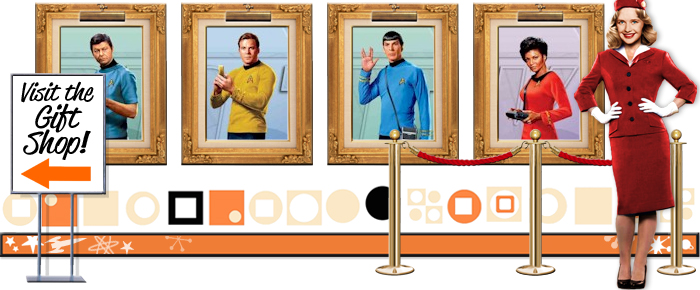 |
|
|
|
Content intended for
informational and educational purposes under the GNU Free
Documentation Areement.
"Star Trek", the
Star Trek logos and images copyright © CBS Studios Inc. |
|
|